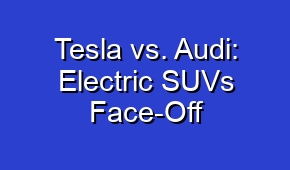Car Restoration Tips

Car restoration tips: Start with a solid plan, research parts and suppliers, take your time, document the process, and seek professional help when needed.
When restoring a car, it’s important to follow some essential car restoration tips to ensure successful results. Start by thoroughly inspecting the vehicle for any damage or rust that needs to be addressed. Car restoration requires careful planning and budgeting, so make sure to create a detailed plan and set a realistic budget. Research the specific model and year of your car to gather all the necessary information and locate any hard-to-find parts. Choose high-quality materials and tools for the restoration process to achieve a professional finish. Take your time and be patient, as car restoration is a meticulous process that requires attention to detail.
| 1. Regular maintenance is crucial for car restoration to prevent further damage. |
| 2. Properly storing your classic car can help preserve its condition. |
| 3. Research and gather all necessary parts before starting the restoration process. |
| 4. Sanding and priming are essential steps in achieving a smooth paint job. |
| 5. Carefully removing rust and applying anti-corrosion treatments can prolong your car’s lifespan. |
- Engine overhaul may be required to restore optimal performance.
- Replacing worn brake components ensures safe driving during restoration.
- Upholstery repair or replacement can enhance the interior aesthetics of your car.
- Using original or high-quality reproduction parts maintains authenticity in restoration.
- Applying a protective clear coat helps preserve the paint and prevent fading.
What are the best car restoration tips for beginners?
If you’re new to car restoration, start by researching and learning about different car models. Understand the basics of automotive mechanics and familiarize yourself with common restoration tools. Create a detailed plan and budget for your project, taking into account the cost of parts, tools, and any professional help you might need. Prioritize safety by wearing protective gear and following proper procedures. Remember to document your progress and take before and after photos to track your achievements. Lastly, don’t be afraid to seek guidance from experienced enthusiasts or join online forums for advice and support.
What are some important car restoration mistakes to avoid?
Avoid rushing the restoration process and skipping important steps. Ensure you have a clear understanding of the car’s structure and mechanics before starting. Don’t overlook the importance of rust prevention and repair, as it can lead to major issues down the line. Avoid using incorrect or incompatible parts that may compromise safety or performance. Always double-check your work and address any issues promptly to prevent further damage. Lastly, resist the temptation to cut corners or take shortcuts, as it may result in poor quality work.
How can I choose the right car for restoration?
When selecting a car for restoration, consider factors such as availability of parts, budget, and personal preference. Research popular car models and their restoration potential. Assess the condition of the vehicle, looking for signs of rust or major structural damage. Ensure the car’s title is clear and check for any legal issues or restrictions. Seek expert opinions or consult with experienced enthusiasts to gather insights on specific models. Remember to factor in the time and effort required for the restoration process.
What are some essential tools needed for car restoration?
Having the right tools is crucial for successful car restoration. Invest in a good set of wrenches, screwdrivers, and socket sets for general repairs. Specialty tools like a torque wrench, compression tester, and multimeter are also helpful. Consider getting a sandblaster for removing rust and a welding machine for structural repairs. Proper safety equipment, such as gloves, goggles, and a fire extinguisher, should not be overlooked. Remember to keep your tools organized and in good condition for maximum efficiency.
What are the steps involved in car body restoration?
Car body restoration typically involves several steps. Start by thoroughly cleaning the exterior and removing any trim or accessories. Assess the extent of damage and make a plan for repairs, including addressing rust or dents. Strip the old paint and apply primer before painting the car in layers. Finish with a clear coat for protection and shine. Reinstall trim, accessories, and glass, ensuring proper alignment and fit. Lastly, buff and polish the car’s body for a flawless finish.
How can I prevent rust during car restoration?
Rust prevention is essential in car restoration to maintain the integrity of the vehicle. Start by thoroughly cleaning and drying the car’s surfaces. Apply a rust converter or inhibitor to any existing rust. Use high-quality primers and paints designed for rust prevention. Consider applying an undercoating or rustproofing product to vulnerable areas. Regularly inspect the vehicle for signs of rust and address any issues promptly. Store the car in a dry, climate-controlled environment when not in use.
What are some tips for restoring the car’s interior?
Restoring a car’s interior requires attention to detail and careful planning. Remove the seats, carpet, and trim to assess the condition and plan necessary repairs. Clean or replace upholstery, ensuring a snug fit. Repair or replace any damaged dashboard components or gauges. Consider upgrading the audio system or adding modern features while maintaining the classic aesthetic. Complete the restoration by thoroughly cleaning and detailing the interior. Preserve the restored interior by keeping it clean and protected from sun damage.
How can I ensure the authenticity of vintage car parts during restoration?
Ensuring the authenticity of vintage car parts is crucial for a true restoration. Research the original specifications and features of the car model you’re restoring. Consult reputable vintage car part suppliers or dealers who specialize in authentic parts. Inspect the parts closely for markings, serial numbers, or manufacturer logos. Seek expert opinions or consult with experienced enthusiasts to verify the authenticity. Keep documentation and receipts for all purchased parts to maintain a record.
What are the best practices for engine restoration?
Engine restoration requires careful attention to detail and proper planning. Start by thoroughly cleaning the engine and its components. Inspect for any signs of damage or wear, such as leaks or corrosion. Replace worn-out or damaged parts with high-quality replacements. Follow the manufacturer’s specifications and torque settings during reassembly. Consider rebuilding the engine if necessary or seeking professional assistance. Properly break in the restored engine and regularly maintain it for optimal performance.
What are some tips for choosing the right paint color during car restoration?
Choosing the right paint color is a crucial decision in car restoration. Research and study the original paint colors available for the car model and era. Consider factors such as historical accuracy, personal preference, and resale value. Obtain paint samples or use digital visualization tools to preview the chosen color. Consult with experts or experienced enthusiasts for advice on color matching and authenticity. Ensure proper preparation and application techniques to achieve a flawless paint finish.
How can I maintain the value of a restored classic car?
To maintain the value of a restored classic car, proper care and maintenance are essential. Store the car in a dry, climate-controlled environment to prevent deterioration. Regularly clean the exterior and interior, removing any dirt or debris. Utilize protective coverings or car wraps to shield the car from harsh weather conditions. Perform regular inspections and address any issues promptly to prevent further damage. Keep detailed records of maintenance and restoration work for potential buyers.
What are some tips for budget-friendly car restoration?
Restoring a car on a budget requires strategic planning and resourcefulness. Set a realistic budget and prioritize necessary repairs over cosmetic enhancements. Consider purchasing used or salvaged parts in good condition to save money. Perform as much of the restoration work as possible yourself, learning new skills along the way. Research and compare prices from different suppliers to find the best deals. Take advantage of online platforms and forums to seek advice and potentially find affordable resources.
What are the steps involved in electrical system restoration?
Restoring the electrical system of a car requires proper knowledge and caution. Start by disconnecting the battery and removing any damaged or outdated wiring. Inspect and clean connectors, ensuring proper conductivity. Replace faulty or worn-out components such as switches, fuses, or relays. Test the electrical system thoroughly before reassembly. Consider upgrading to modern wiring harnesses or features for improved performance and reliability.
How can I protect a restored car from environmental damage?
Protecting a restored car from environmental damage is crucial for its longevity. Regularly wash and wax the car’s exterior to protect the paint and prevent corrosion. Utilize protective coatings or films to shield vulnerable areas from UV rays and road debris. Store the car indoors or under a high-quality car cover when not in use. Avoid exposing the car to extreme weather conditions or prolonged sunlight. Perform regular inspections and maintenance to address any potential issues promptly.
What are some common challenges faced during car restoration?
Car restoration can present various challenges, including rust repair, parts availability, and mechanical issues. Overcoming rust and structural damage requires proper techniques and attention to detail. Finding rare or discontinued parts may involve extensive research and networking with other enthusiasts. Addressing mechanical issues requires knowledge and potentially seeking professional assistance. Time management and staying motivated throughout the restoration process can also be challenging. However, with patience, persistence, and the right resources, these challenges can be overcome.
What are some tips for transforming a vintage car into a custom hot rod?
Transforming a vintage car into a custom hot rod requires careful planning and creativity. Research and design a vision for the desired hot rod style and appearance. Consider modifications such as engine upgrades, suspension enhancements, and body customizations. Ensure all modifications comply with legal and safety regulations. Collaborate with experienced builders or fabricators to execute the modifications. Regularly maintain and fine-tune the hot rod for optimal performance and enjoyment.
How can I improve the performance of a restored classic car?
To improve the performance of a restored classic car, several factors should be considered. Consider upgrading the engine, intake, or exhaust system for increased power. Optimize the suspension and braking systems for improved handling and safety. Upgrade to modern tires and wheels for enhanced grip and stability. Ensure proper tuning and maintenance of the engine and other mechanical components. Regularly test and fine-tune the car’s performance to achieve optimal results.





















